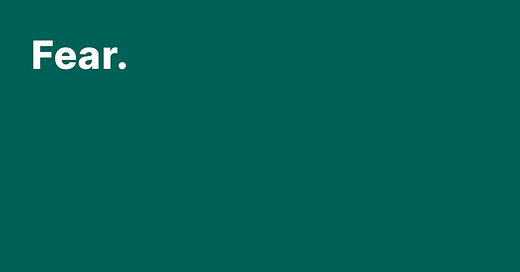Fear is one of the most talked-about emotions in trading.
And also one of the most misunderstood.
We learn to manage our fear. Fade our fear. Measure the fear of other market players.
Yet fear, as I’ve come to understand it, is actually a facade.
It arises as an attempt to protect us from that which we do not want to experience.
When the threat of an experience feels too overwhelming, fear manifests as a shield, and we ricochet off it.
We instinctively move in the opposite direction from that which fear conceals.
When we act from our fear, we abandon our predetermined plans.
When we force ourselves to do the opposite of what fear suggests—blindly, because we are told this is what great traders do—we also abandon our predetermined plans.
A better path, I have found, is to move into the fear itself. To puncture its facade.
To allow the emotions below it to wash over our internal experience and, in doing so, to release those emotions’ ravenous yearning to be acknowledged.
Such a ritual can be modeled from the samurai training known as “death meditation.”
This practice, conducted in preparation for battle, involved daily meditation on various scenarios of one's own death.
The scenarios included being ripped apart by arrows, drowning under surging waves, being burned alive, falling from thousand-foot cliffs, dying of disease, and committing seppuku (ritual suicide).
Such meditations, counterintuitively, helped samurai to develop a state of mental calmness and readiness for combat.
They enabled samurai to cultivate an acceptance of death as an inevitable part of life; to reduce the emotions and anxieties associated with dying; to enhance their focus and clarity in battle; and to develop a sense of detachment from outcomes.
The samurai achieved this state not by acting from their fear. Nor by reacting to their fear. Nor by numbing their fear away.
They moved into their fear, and allowed the kaleidoscope of emotions that fear’s facade had concealed to be experienced in vivid, embodied detail.
What samurai training reveals is that when we refuse to probe below fear’s facade, we lose our capacity for focus and clarity.
We lose our detachment from outcome.
We act from the fear, rather than from our training.
It shows us how fear is actually a shield, attempting to protect us from that which we do not want to experience.
It shows us that by embracing all that fear is attempting to protect us from, the pressure within fear’s cauldron is alleviated.
And on the other side of that ritual is a focus, clarity and impartiality from which we can act.
As traders, we are not risking our lives in our work.
Yet, when fear strikes, the inner experience can feel as though we are facing death.
Our livelihood, our dreams, our very freedom feel at risk.
Perhaps it is our account slowly bleeding out across multiple months—dying of disease.
Perhaps it is a systemic shock forcing multiple positions past their risk points all at once—being ripped apart by arrows.
Perhaps it is a period of extreme volatility repeatedly pulling us into markets only to stop us out—drowning under surging waves.
When we reach such periods in our trading—which are inevitable over a career—we are faced with a choice:
We can ricochet off fear’s facade.
Or, we can instead turn into the fear, accepting and allowing those emotions we do not want to feel to wash over us. We can deeply experience all that fear is attempting to protect us from.
Shame over losing an account.
Embarrassment about returning to a job.
Grief over the death of our dream.
And on the other side of that ritual, we can reclaim the focus, clarity, and impartiality needed to access our training, and act from integrity.



